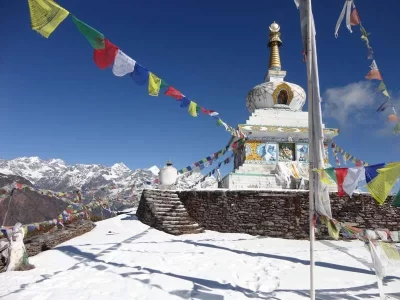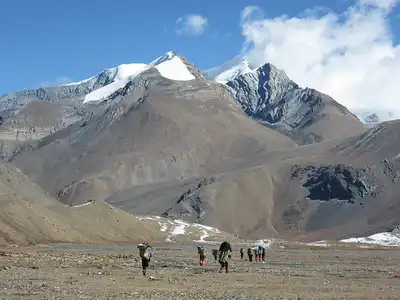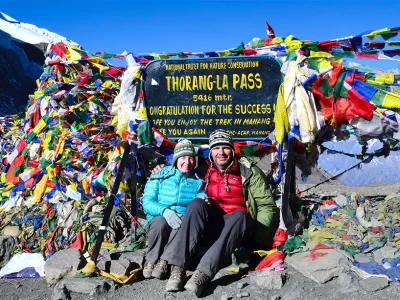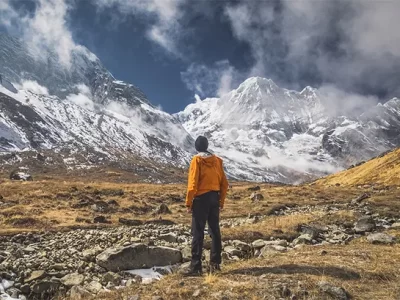Trekking in Nepal presents a unique opportunity to escape the frenetic lifestyle of cities and towns and discover a whole other realm. Trekking in Nepal offers you an absolute blast with an utterly unique view of landscape and greenery, from the north of the Himalayas to the streams and creeks to the flat farming area of the south. Trekking in Nepal is one of those once-in-a-lifetime experiences that have been popular since the nineties. One will also master the cultural and religious practices of the individuals who dwell in the Himalayan region of Nepal. Nepal has over 100 famous Himalayas and peaks, granting incredible experiences from east to west.
Trekking in Nepal Packages
Rara Lake Trek
Langtang Gosaikunda Helambu Trek
Tilicho Lake Trek
Kanchenjunga Base Camp Trek
Ama Yangri Trek
Everest Base Camp Trek for Beginners
Everest Base Camp Short Trek
Mardi Himal Trek
Everest Base Camp Trek with Helicopter Return
Luxury Everest Base Camp Trek
Everest Base Camp Trek
Upper Dolpo Trek
Upper Mustang Trek
Manaslu Circuit Trek
Tsum Valley Trek
Dhaulagiri Trek
Mini Annapurna Circuit Trek
Ghorepani Poon Hill Trek
Annapurna Circuit Trek
Rolwaling Tashi Lapcha Pass Trek
Gokyo Renjo La Pass Trek
Mani Rimdu Festival Trek
Everest View Trek
Jiri to Everest Base Camp Trek
Langtang Valley Trek
Langtang Gosaikunda Trek
Everest High Pass Trek
Gokyo Lakes Trek
Gokyo Cho La Pass Trek
Everest Panorama Trek
Annapurna Base Camp Trek
Landscapes and Terrains
Nepal’s landscapes extend beyond the clouds and awe all trekkers and travelers that trek through this country. Eastern Nepal offers you a trek to the marvelous Everest, Ama Dablam, Kanchenjunga, Lhotse, and Gokyo RI, as well as picturesque hamlets underneath these summits. Trekking in Nepal will be different from trekking in other countries since every region of Nepal has unique natural characteristics that will wow trekkers. The same is valid for western Nepal, where sky-touching mountains like Annapurna, Makalu, Dhaulagiri, Nilgiri, and many others are convenient for trekking.
These regions enter paradise and provide a new viewpoint of the alpine landscapes. Additionally, one may take a splendid Chitwan rainforest safari and explore several ancient spots in the south. In the plains south of Kathmandu, there are two national parks: Bardiya and Chitwan. Since the dawn of time, these national parks have been popular tourist attractions. The Sagarmatha National Park, Langtang National Park, Annapurna Conservation Area, Makalu Barun National Park, and Manaslu Conservation Area are some national parks you may visit when trekking in Nepal.
Consequently, the vast bulk of Nepal’s cliffs and the terrain is rocky and steep. These hills will have sharp edges and a deep valley at their base, with a deep river cutting through the base of the hill. Likewise, the trails will be narrow and occasionally cloudy, reducing visibility. There will also be a greater risk of altitude sickness over 3000 meters above sea level. Therefore, if you take care of all these potential challenges, you may ascend all of Nepal’s peaks and mountains in the optimal manner possible. In addition, the valleys, canyons, glaciers, meadows, and mountain passes provide a substantial and mesmerizing tone for trekking in Nepal.
Weather and Climate
Trekking in Nepal will be a lifetime experience if you are familiar with Nepal’s weather systems. Nepal’s weather is constantly changing, especially in the hilly and Himalayan regions. The erratic weather, downpours of rain, and glorious sunshine give all the greenery and wildlife an exotic vibrancy. Additionally, the rainy season lasts from June to September, and from November to February, snow covers the whole northern mountain range of Nepal from east to west. The most significant times for trekking in Nepal are spring and autumn. Trekking in Nepal will be especially suitable from March to May and from the end of September to November.
Similar to how it will be hotter and more humid in the south than in the north of Nepal, so will it be in the plains. Most of the agricultural land in Nepal’s south, which stretches from east to west, is comprised of lowlands. Moreover, the temperature gradually decreases as you proceed steadily northward and gain altitude. Subsequently, the Bay of Bengal’s chilly wind, which blows from the east, causes heavy rain to fall throughout most of Nepal. The terrain will be treacherous at this period, and landslides and floods may be possible throughout the country.
Forecasting the weather will thus be a crucial step when trekking in Nepal. Besides, the temperature will moderate when trekking through the hills and valleys, giving you an astounding panorama of diverse attractions. When the sky is clear, over 5000 meters, you can admire the Himalayas’ jovial white faces and stunning vivid blue glaciers. In terms of water resources, Nepal is the second-richest country. Therefore there will be incredible opportunities to witness waterfalls falling from the lush landscapes.
Culture and lifestyle
Trekking in Nepal allows you to blend in the rich diversity and culture of the people living in the Himalayan region. Nepal’s valleys and the Himalayan region are home to people from indigenous groups such as the Gurung, Sherpa, Rai, and Limbu. On your trek to the northern Himalayas, you will also traverse through the communities of these people. On top of that, they value your presence in their communities humbly. A grin will be on their faces when they greet you. Additionally, the Gurung people inhabit the Manaslu, Annapurna, and Manang regions of Nepal’s western Himalayas. The northern region of Annapurna and Manang is home to several tribes with Tibetan influences.
Similarly, you will encounter the Sherpa inhabitants and their hamlets at the foot of the Himalayas in the eastern region of Nepal, adjacent to the Everest region. They are a legendary tribe of trekkers with a wide range of trekking abilities residing in the Himalayas’ shadow. And these individuals, in particular, depend on the tourism sector and cattle ranching. Similarly, diverse groups celebrate festivals like Lohsar, Dashain, Tihar, Ubhauli, Gai Jatra, and others. The stunning view of these hamlets from the top of the mountains will be another significant aspect of trekking in Nepal. Besides, you may discover traditional arts and crafts that depict the history of the local inhabitants of the region.
Subsequently, you will come across several monasteries, cathedrals, statues, and other structures that are UNESCO world historical sites. It will also assist you in understanding more about the local customs and culture if you pass through these communities while trekking in Nepal. Similarly, there is a reasonable likelihood of running into festival season. You could get the opportunity to celebrate traditional festivities with indigenous Nepalese people throughout the country’s festival season. You can sample some delicious traditional Nepali dishes as well. Everything around these Himalayan regions is fresh and organic, from the excellent meat varieties to the fruits like oranges and apples.

































